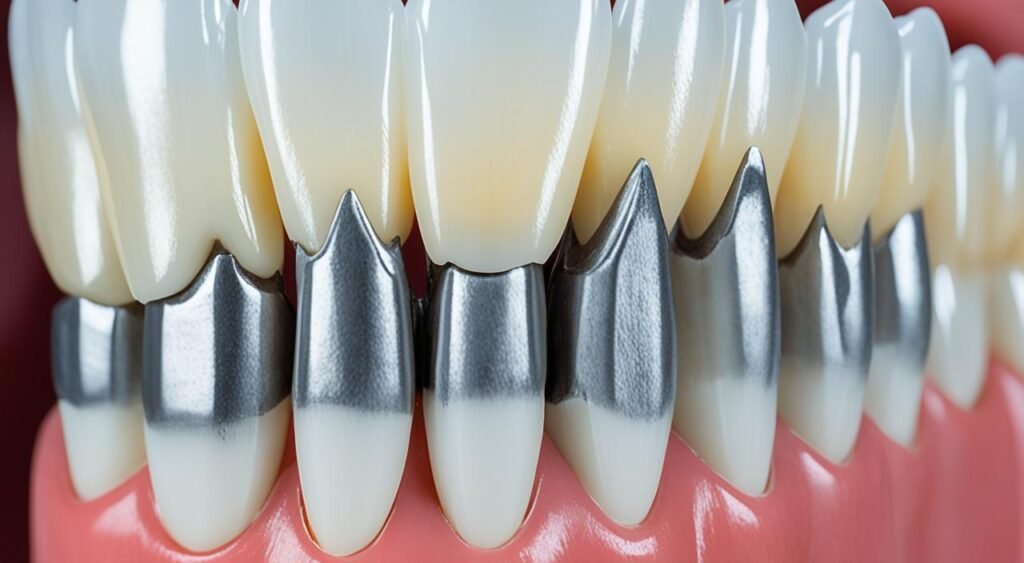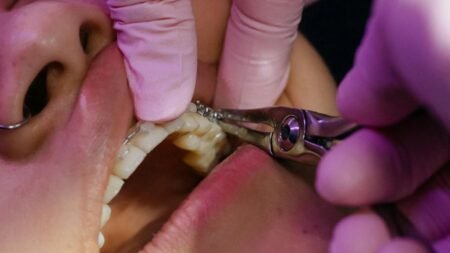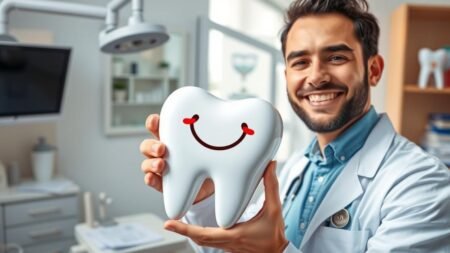When it comes to dental health, we often focus on our pearly whites, but what about our canine teeth? These sharp, pointed teeth play a vital role in our overall oral well-being. Have you ever wondered why we have canine teeth, or how they differ from other teeth? Are there any common misconceptions about canine tooth health? And what are the best ways to maintain their health?
In this article, we will dive deep into the world of canine teeth. From their intriguing structure and anatomy to their development in humans, we’ll uncover the mysteries behind these fascinating teeth. We’ll also discuss common issues that can arise with canine teeth, such as extraction, pain, and fractures, and provide valuable tips for prevention and care.
So, are you ready to explore the secrets of canine teeth and discover how to keep them in optimal health? Let’s get started!
Understanding Canine Tooth Structure and Anatomy
When it comes to the health and maintenance of your canine teeth, understanding their structure and anatomy is crucial. Canine teeth, also known as cuspids or eye teeth, are the pointed teeth located on either side of the incisors. These teeth are considered one of the most vital components of our oral health.
Compared to other teeth in the mouth, canine teeth possess unique characteristics that contribute to their role in chewing and tearing food. Their long and robust roots anchor them firmly in the jawbone, providing stability and strength.
The shape of canine teeth is distinct, featuring a sharp and pointed tip that stands out in the mouth. This pointed structure aids in gripping and tearing food, allowing for effective mastication. Additionally, canine teeth have a thicker layer of enamel, which makes them more resistant to wear and tear compared to other teeth.
Understanding the anatomy of canine teeth also involves recognizing their position in the dental arch. Canine teeth are strategically located at the corners of the mouth. Their placement allows them to guide the alignment of other teeth and maintain proper occlusion, ensuring an appropriate bite.
To give you a better visual representation, here is a table summarizing the unique characteristics and anatomy of canine teeth:
| Characteristic | Description |
|---|---|
| Location | Located on either side of the incisors |
| Shape | Pointed tip for tearing and gripping food |
| Roots | Long and robust, providing stability |
| Enamel Thickness | Thicker enamel for enhanced durability |
| Function | Aids in chewing, tearing, and maintaining proper occlusion |
By understanding the canine tooth structure and anatomy, you can appreciate their importance in maintaining overall oral health. Next, let’s explore the development of canine teeth in humans to further deepen our knowledge.
Canine Tooth Development in Humans
Canine teeth play a vital role in dental health, and understanding their development is crucial. Let’s take a closer look at the timeline and stages of canine tooth development in humans, from eruption to full maturity. We’ll also explore common developmental issues that may arise and discuss effective ways to address them.
Timeline of Canine Tooth Development
The development of canine teeth in humans follows a specific timeline, starting from the eruption of the primary canine teeth and continuing through the eruption of the permanent canines. Here is a general timeline:
- Eruption of primary canine teeth: Primary canines usually erupt between the ages of 16 to 20 months.
- Loss of primary canines: Between the ages of 10 to 12 years, the primary canines are typically replaced by permanent canines.
- Eruption of permanent canines: The permanent canines usually erupt between the ages of 11 to 12 years.
- Maturity of permanent canines: By the age of 13 to 15 years, the permanent canines are fully mature.
It’s important to note that the eruption timeline can vary from person to person.
Common Developmental Issues and Solutions
During canine tooth development, certain issues may occur, which can impact oral health. Here are some common problems and solutions:
Delayed eruption: Sometimes, permanent canines may not erupt on time. This can cause crowding or misalignment of surrounding teeth. In such cases, orthodontic intervention may be necessary to guide their proper eruption.
Impacted canines: Impacted canines occur when the teeth are trapped within the jawbone and fail to erupt. Orthodontic treatment can help align and guide the impacted canines into their proper positions.
Supernumerary canines: This refers to the presence of extra canine teeth, which can lead to overcrowding and alignment issues. Orthodontic evaluation and treatment can help address the overcrowding caused by supernumerary canines.
Addressing Canine Tooth Development Issues
If you suspect any issues with the development of your canine teeth or notice any signs of misalignment or impaction, it is crucial to consult with a dental professional. They will assess your case and recommend appropriate treatment options to ensure optimal dental health and proper functioning of canine teeth.
Understanding the development of canine teeth in humans allows us to recognize and address potential issues early on, promoting better oral health and overall well-being.
Maintaining Canine Teeth Health
Proper maintenance is crucial for ensuring the health and longevity of your canine teeth. By taking simple steps to care for your teeth, you can prevent dental problems and maintain optimal oral health.
Daily Oral Hygiene Practices
- Brush your teeth at least twice a day with a soft-bristled toothbrush and fluoride toothpaste.
- Pay special attention to brushing your canine teeth, as they are more prone to plaque buildup and tartar formation.
- Floss daily to remove food particles and plaque from between your teeth, including your canines.
Healthy Diet for Canine Tooth Health
Eating a well-balanced diet contributes to overall dental health, including the health of your canine teeth. Incorporate the following foods into your diet:
- Fresh fruits and vegetables rich in vitamins and minerals.
- Lean proteins such as chicken, fish, and tofu.
- Dairy products like milk, cheese, and yogurt for calcium.
Regular Dental Check-ups
Make sure to schedule regular dental check-ups with your dentist to monitor the health of your canine teeth. Dental professionals can identify early signs of dental issues and recommend appropriate treatment or preventive measures. Regular cleanings and check-ups help maintain proper oral hygiene and prevent potential problems.

Avoid Habits That Can Harm Canine Teeth
- Avoid chewing on hard objects, such as ice, pens, or hard candies, as it can cause fractures or damage to your canine teeth.
- Avoid using your teeth as tools to open bottles or tear packaging. This can lead to chipping or cracking of your canines.
- Limit consumption of sugary and acidic foods and beverages, as they can contribute to tooth decay and enamel erosion.
Protective Measures
If you actively participate in sports or activities with a high risk of dental injuries, consider wearing a mouthguard to protect your teeth, including your canines. Mouthguards provide an extra layer of protection and can prevent damage to your teeth during impact or accidents.
Maintaining proper oral hygiene practices, adopting a healthy diet, and seeking regular dental care are essential for keeping your canine teeth healthy and preventing dental problems. By investing time and effort into caring for your teeth, you can enjoy a beautiful and healthy smile for years to come.
Common Issues with Canine Teeth
Canine teeth, like any other teeth, can be susceptible to various issues that may arise. It’s essential to be aware of these common problems, such as canine tooth extraction, canine tooth pain, and canine tooth fractures, in order to address them promptly. Understanding the causes, symptoms, and available treatment options will enable you to take appropriate action and preserve the health of your canine teeth.
Causes and Symptoms
Canine tooth extraction may be necessary due to severe damage or decay, impaction, or orthodontic treatment requirements. The extraction process involves the careful removal of the affected canine tooth by a qualified dentist or oral surgeon.
Canine tooth pain can stem from various factors, including tooth decay, dental abscess, gum disease, or even teeth grinding. Common symptoms of this type of pain include throbbing or sharp discomfort, sensitivity to temperature or pressure, and swelling around the affected tooth. It’s important to note that persistent or severe pain requires prompt dental attention.
Canine tooth fractures can occur due to trauma, such as a sports injury, biting down on a hard object, or a fall. Fractures can range from minor cracks to more severe breaks, presenting different symptoms. These may include pain, sensitivity, visible cracks or chips, or even tooth mobility. Seeking immediate dental care is vital to prevent further complications.
Treatment Options
The treatment for canine tooth extraction involves a thorough examination of the affected tooth and surrounding structures. The dentist will implement necessary measures to ensure a comfortable and successful extraction. In some cases, a replacement tooth, such as a dental implant or bridge, may be recommended to maintain proper oral function and aesthetics.
To address canine tooth pain, the underlying cause must be identified and treated accordingly. This may involve procedures such as root canal therapy, dental fillings, or gum treatments. Pain management options, including medication or desensitizing agents, can provide relief while the treatment progresses.
Canine tooth fractures require immediate attention to prevent further damage and infection. Treatment options will depend on the severity and location of the fracture. Minor fractures can often be repaired with dental bonding or veneers, while more severe cases may require a dental crown or root canal therapy. Extraction may be necessary if the fracture extends below the gum line or affects the tooth’s stability.
Remember, if you experience any issues with your canine teeth, consult a dental professional for a thorough evaluation and appropriate treatment plan. Prompt intervention can help mitigate further complications, preserve your oral health, and restore your smile’s functionality and aesthetics.
The Function of Canine Teeth
Canine teeth, also known as cuspids, have a vital role to play in the human mouth. These sharp and pointed teeth are strategically positioned to serve several essential functions. Let’s explore the diverse roles that canine teeth fulfill, highlighting their significance in oral health.
Tearing and Gripping Food
One of the primary functions of canine teeth is to tear and grip food. Their sharp, pointed edges enable efficient tearing of meat and fibrous foods. Canine teeth work in conjunction with other teeth, such as incisors and molars, to break down food into smaller, more manageable pieces, facilitating the digestion process.
Contributing to Speech
Canine teeth also contribute to the pronunciation of certain sounds during speech. The upper canine teeth play a significant role in producing the “s” and “sh” sounds, while the lower canine teeth aid in articulating the “th” and “v” sounds. Their position in the mouth allows for proper airflow and tongue movement, facilitating clear and precise enunciation.
Maintaining Dental Alignment
Canine teeth serve as natural anchors in maintaining the alignment of the other teeth in the mouth. Their position at the corners of the dental arch creates stability and prevents adjacent teeth from shifting or drifting. This ensures the integrity of the dental structure and promotes a harmonious bite, preventing issues like overcrowding or misalignment.
To better understand the role of canine teeth, here’s a visual representation:
| Function | Examples |
|---|---|
| Tearing and gripping food | Tearing apart a piece of meat or ripping into fibrous vegetables |
| Contributing to speech | Pronouncing the “s,” “sh,” “th,” and “v” sounds |
| Maintaining dental alignment | Preventing adjacent teeth from shifting or drifting |
By understanding the crucial function of canine teeth, we can appreciate the significance of their maintenance and preservation. Ensuring their health and functionality is essential for optimal oral well-being.
Canine Tooth Implants as a Solution
For individuals with missing or damaged canine teeth, canine tooth implants offer a reliable and effective solution. This dental procedure involves the placement of artificial tooth roots to secure prosthetic teeth firmly in place, restoring both functionality and aesthetics. Let’s explore the process, benefits, and considerations associated with canine tooth implants.
The Process of Getting Canine Tooth Implants
The first step towards getting canine tooth implants is a thorough examination and consultation with a qualified dental professional. They will assess your oral health, review your medical history, and discuss your goals and expectations. Once you are deemed suitable for the procedure, the implant process generally follows these steps:
- Placement of the implant: The dentist surgically places the implant into the jawbone to function as an artificial tooth root.
- Osseointegration: Over a period of a few months, the implant fuses with the jawbone through a process called osseointegration, ensuring stability and durability.
- Abutment placement: After osseointegration, the dentist attaches an abutment to the implant, which serves as a connector between the implant and the prosthetic tooth.
- Prosthetic tooth placement: Finally, the dentist attaches the custom-made prosthetic tooth to the abutment, creating a natural-looking and functional replacement for the missing or damaged canine tooth.
Benefits of Canine Tooth Implants
Canine tooth implants offer several significant benefits, including:
- Enhanced aesthetics: The prosthetic tooth closely resembles a natural canine tooth, providing a seamless and natural-looking smile.
- Restored functionality: With canine tooth implants, individuals can regain the ability to bite, chew, and speak comfortably.
- Improved oral health: Implants help preserve the integrity of the jawbone and surrounding teeth by preventing bone loss and maintaining proper dental alignment.
- Long-lasting solution: When properly cared for, canine tooth implants can last a lifetime, making them a durable and cost-effective choice in the long run.
Considerations for Canine Tooth Implants
While canine tooth implants can be a suitable option for many individuals, certain considerations should be taken into account:
It’s crucial to have a healthy jawbone and gums to support the implant. If there is insufficient bone density or gum disease present, additional procedures such as bone grafting or gum treatment may be necessary before the implant placement.
Additionally, factors such as overall oral health, medical conditions, and lifestyle habits can impact your candidacy for the procedure. Consulting with a knowledgeable dentist will help determine if canine tooth implants are the right choice for you.
Remember, proper care and maintenance are key to the long-term success of canine tooth implants. Regular dental check-ups, thorough oral hygiene practices, and avoiding habits that may damage the implant are essential for preserving your restored smile.
Prevention and Care for Canine Teeth
Maintaining healthy canine teeth is crucial for your overall dental well-being. By implementing preventive measures and practicing proper care, you can ensure the long-term health and vitality of your canine teeth.
One important aspect of canine tooth care is paying attention to your diet. Consuming a nutritious, balanced diet that includes essential vitamins and minerals promotes strong teeth and gums. Incorporate foods rich in calcium, such as dairy products and leafy greens, to support dental health.
In addition to diet, it’s essential to avoid habits that can damage your canine teeth. Refrain from using your teeth as tools to open bottles or packages, as this can lead to fractures and chips. Similarly, avoid chewing on hard objects like ice or pens, which can cause excessive wear and tear on your teeth.
Maintaining a consistent oral hygiene routine is vital for canine tooth health. Brush your teeth twice a day with a soft-bristled toothbrush and fluoride toothpaste. Don’t forget to clean along the gumline and reach every corner of your mouth effectively. Regular dental check-ups and professional cleanings with your dentist are also crucial for detecting and addressing any potential issues promptly.
FAQ
What is the structure and anatomy of canine teeth?
Canine teeth are long, pointed teeth that resemble fangs. They have a single root, a sharp crown, and strong enamel, making them ideal for tearing and gripping food.
How do canine teeth develop in humans?
Canine tooth development begins around the age of four and typically finishes by the age of twelve. They erupt after the incisors and play a crucial role in the alignment and function of the mouth.
How can I maintain the health of my canine teeth?
To maintain the health of your canine teeth, it is important to practice good oral hygiene. This includes brushing twice a day, flossing regularly, and visiting your dentist for regular check-ups and cleanings.
What are some common issues with canine teeth?
Common issues with canine teeth include extraction due to severe decay or crowding, pain caused by infections or fractures, and fractures resulting from trauma or accidents.
What is the function of canine teeth?
Canine teeth are essential for tearing and gripping food, contributing to proper speech pronunciation, and maintaining the alignment of the other teeth in the mouth.
Are canine tooth implants a solution for missing or damaged canine teeth?
Yes, canine tooth implants can be a viable solution for individuals with missing or damaged canine teeth. They provide a natural-looking and functional replacement, restoring both the appearance and function of the tooth.
How can I prevent and care for my canine teeth?
Preventive measures for canine teeth include avoiding habits that can damage the teeth, such as biting hard objects or grinding the teeth. Regular dental check-ups, proper oral hygiene, and a balanced diet also contribute to their care and well-being.








